What Makes a Good Product Roadmap?
An effective product roadmap presents a high-level, visual overview of the timeline and goals of your product, as well as the product’s long-term direction and plans for future iterations.
Product management teams use roadmaps to assign team members to each phase of the product. Phases include planning, tracking, and managing the roadmap throughout the product’s lifecycle.
A strong product roadmap effectively prioritizes tasks and initiatives, and also accomplishes the following:
- Tracks overall progress towards the end product goal
- Coordinates tasks and activities across teams
- Creates a strong consensus and understanding between teams regarding the product’s direction
- Provides transparency and open communication, both internally and externally, among stakeholders
Basic Steps in Creating a Product Roadmap
Managers can use the following key steps to build a product roadmap: create a vision and strategy, determine the audience, develop product themes, set product scope and goals, create a hypothesis for your goals, and remain flexible.
1. Create a High-Level Product Vision and Strategy.
The first step of all product roadmaps is to determine the “why” behind the product. Ask yourself and your team why you are developing this product and how you will prioritize its specific attributes.
Additionally, identify the value the product will deliver to your customers. Take into account value that doesn’t exist in other competing products.
Create a specific business model that identifies these key points and how the product and its updates will generate revenue. That information will help point you in the right direction regarding prioritization and strategy.
2. Determine your audience and tailor your roadmap.
Your product roadmap will look different depending on who you are presenting to. You’ll likely want to create roadmaps specifically for management teams, product teams, development teams, and others.
The roadmap needs to be both flexible and useful for each audience and give stakeholders confidence that your product will meet — or exceed — its strategic objectives. Hold conversations with all involved stakeholders across different teams to determine what they care about most and what they need to know about the product’s future plans.
3. Create strategic product themes.
To help guide your roadmap, determine the product’s major themes and create “swimlanes” for each. Use swimlanes to keep the roadmap organized by layering in epics, or large chunks of work that can be further broken down into smaller tasks.
These themes should be broad and overarching, like “improve the new user experience” or “retain X amount of customers.” Then, prioritize themes based on how much they contribute to the overall product strategy, and by current versus future endeavors.
4. Set the product scope and goals.
Now that you have product themes, it’s time to develop the product scope and identify strategic goals. Use both qualitative and quantitative research to pick improvement areas.
Approach this process as a negotiation and collaboration among cross-functional teams. It is rare for everyone to agree on specific scope and goals from the get-go. Instead, this step will likely be an ongoing collaborative effort to determine what’s most important for the strategic objectives of the business.
5. Create a hypothesis for your goals.
Back up every idea with a hypothesis that you need to validate. For each hypothesis, identify a plan for validating it and what you hope to achieve.
6. Stay flexible, as roadmaps will inevitably change.
One of the most vital things to remember is that the roadmap will likely change throughout a product lifecycle. Leave room for these updates and don’t let tweaks to the original plan throw you off course. Especially in Agile environments, you’ll need your roadmap to remain flexible and collaborative.
Constantly revisit the roadmap and adapt it as priorities change and view this practice as a way to collect lessons learned.
Planning for a Product Roadmap
As you plan for a product roadmap, follow the basic steps to ensure you have all the key components. Be sure to include key stakeholders, product details, milestones, and more.
1. Determine Your Audience
Tailor your roadmap based on the needs of your different audiences, and focus on what’s most important for them to know. For example, C-suite level stakeholders will be more interested in a high-level overview of strategic product objectives, while members of the product team will want a more granular, tactical view of specific features and tasks.
Use this helpful chart to determine the type of roadmap to create for each audience so you include all necessary information — and leave out anything that’s not important to that audience.
Audience | Type of Roadmap | Key Elements | Tips for Presentation |
|---|---|---|---|
C-suite (CEOs, CFOs, CPOs, etc.) | High-level |
|
|
Product Development Teams | Granular |
|
|
Web Development Teams | Granular |
|
|
Sales Teams | High-level |
|
|
Marketing Teams | High-level or Granular |
|
|
2. Identify the Roadmap Timeline
Determine how far into the future you want to plan. The timeline should be long enough to get through significant product developments, but short enough that you can still predict accurate deadlines. Also, determine the roadmap’s layout, either by year, quarter, month, or sprint.
3. Assemble Additional Components of Your Product Development Plan
Along with focusing on your audience and timeline, you should also cover high-level goals, tasks, task priorities, milestones, and dependencies. As you map out the roadmap, be sure to incorporate these key elements as well.
Who Is Responsible for Creating the Product Roadmap?
Product managers are responsible for making the product roadmap, as well as for presenting the correct versions to various stakeholders and teams, like sales, marketing, product, web development, and more.
That said, a product roadmap is a collaborative document. Be sure to get stakeholder input on each aspect of the roadmap.
How to Build a Product Roadmap
You can easily build a product roadmap by using one of our pre-built templates and following the steps outlined below.
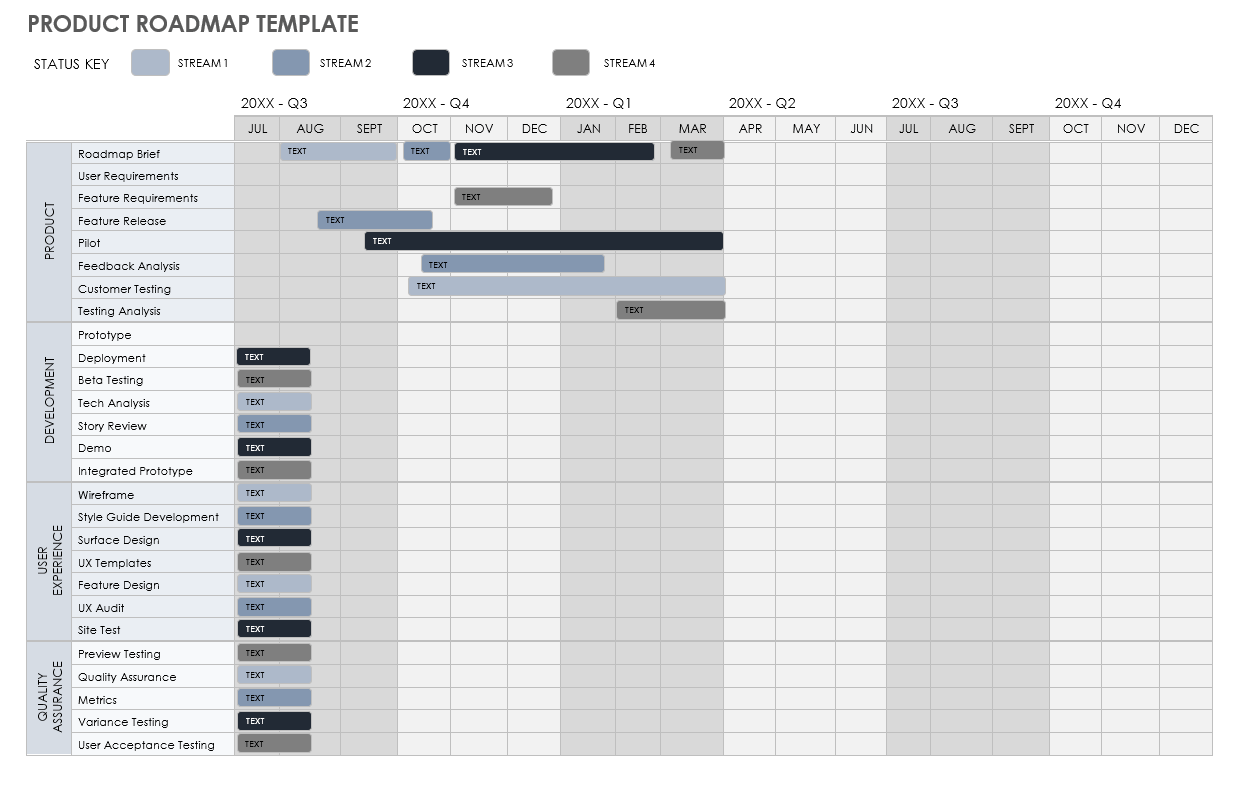
Download Product Roadmap Template
Microsoft Excel | Microsoft Word | Microsoft PowerPoint | Smartsheet
1. Download and Open the Template
Download the template file in the preferred format. For this example, we’ll be building the roadmap using the Microsoft Excel template.
2. Adjust Task Date Ranges
The roadmap is broken up by months and quarters. Double-click within any of the date cells to adjust the dates to meet the appropriate periods of time for your product.
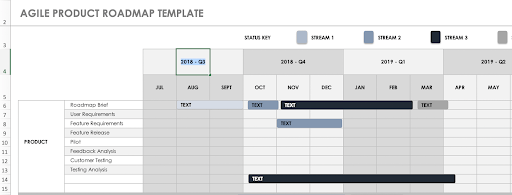
Begin each task bar at the expected start date and extend to the expected end date.
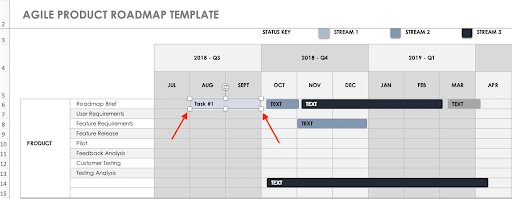
3. Add Task Bars for Each Task
Double-click on any task bar to rename it based on the specific tasks or activities in your roadmap.
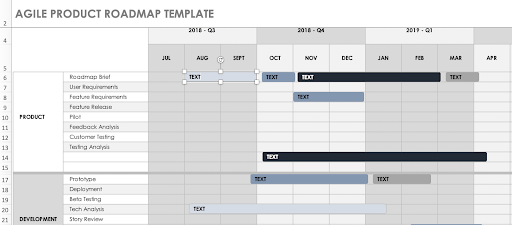
4. Group Bars by Team or Initiative
To better organize the roadmap, group the task bars by team or initiative. These groupings are also known as swimlanes, which help you better understand the roadmap at a glance and ensure you’re analyzing the information correctly.
In our example template, the tasks are grouped together by different initiatives, like product, development, user experience, and quality assurance.
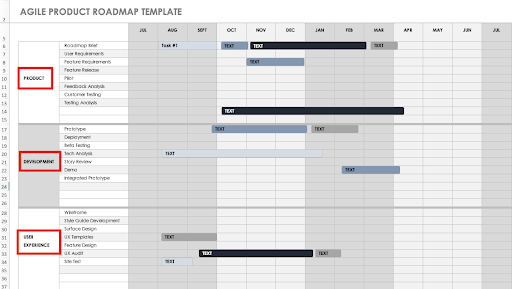
5. Stack Bars by Feature
Stack sequential tasks that are part of the same initiative in the same row, and identify which tasks are part of what phase of the roadmap. You can also use the bars to signify dependencies among tasks.
For example, the tasks in the first row, the Roadmap Brief row, are sequential and must happen in order.
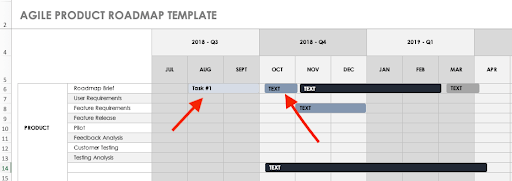
Find additional roadmap templates for a variety of use cases, which you can easily download, customize, and implement across your organization. You can also download free Agile product roadmap templates.
Product Roadmap Design
To better customize your product roadmap, you can apply different settings and designs to help certain components stand out, like prioritized tasks, milestones, and the critical path.
You can also include the following design aspects:
- Task Status: Use colors to categorize tasks based on status or priority. For example, you can use red, yellow, and green to signify tasks that are at risk, in progress, or complete.
- Task Progress: To signify the progress of each task, use different bar fill options.
- Dependencies: Use arrows and connectors to indicate dependencies between tasks, similar to how you show tasks within a flowchart or process map.
- Milestones: To showcase critical milestones, use shapes, like diamonds or stars.
- Current Date: Ensure that people understand the current date, as opposed to projected dates, by using a dotted, horizontal line to indicate where you currently are on the product roadmap.
- Critical Tasks or Paths: Use bolded borders, text, or outlines to highlight critical tasks or create a critical path that team members and stakeholders can easily view.
How to Choose the Right Product Roadmap Tool
An online product roadmap tool can save time and increase efficiency in several ways. Live, shareable documents allow for easy collaboration, and also make it easier to track history and versioning. Additionally, many programs offer pre-built templates.
Here is a list of some of the most popular roadmapping tools:
- Craft helps you build epics and stories, and translate those into a visual roadmap.
- Lucidchart offers real-time collaboration, with a simple user interface.
- Onedesk helps you identify and prioritize requirements.
- ProductPlan includes drag-and-drop features, which enable you to view several roadmaps in a master plan.
- Smartsheet offers a Gantt chart with various views, customization features such as color and symbols, and real-time collaboration.
How to Create a Product Roadmap in Microsoft PowerPoint
You can also create a product roadmap in Microsoft PowerPoint. To do so, follow these step-by-step instructions.
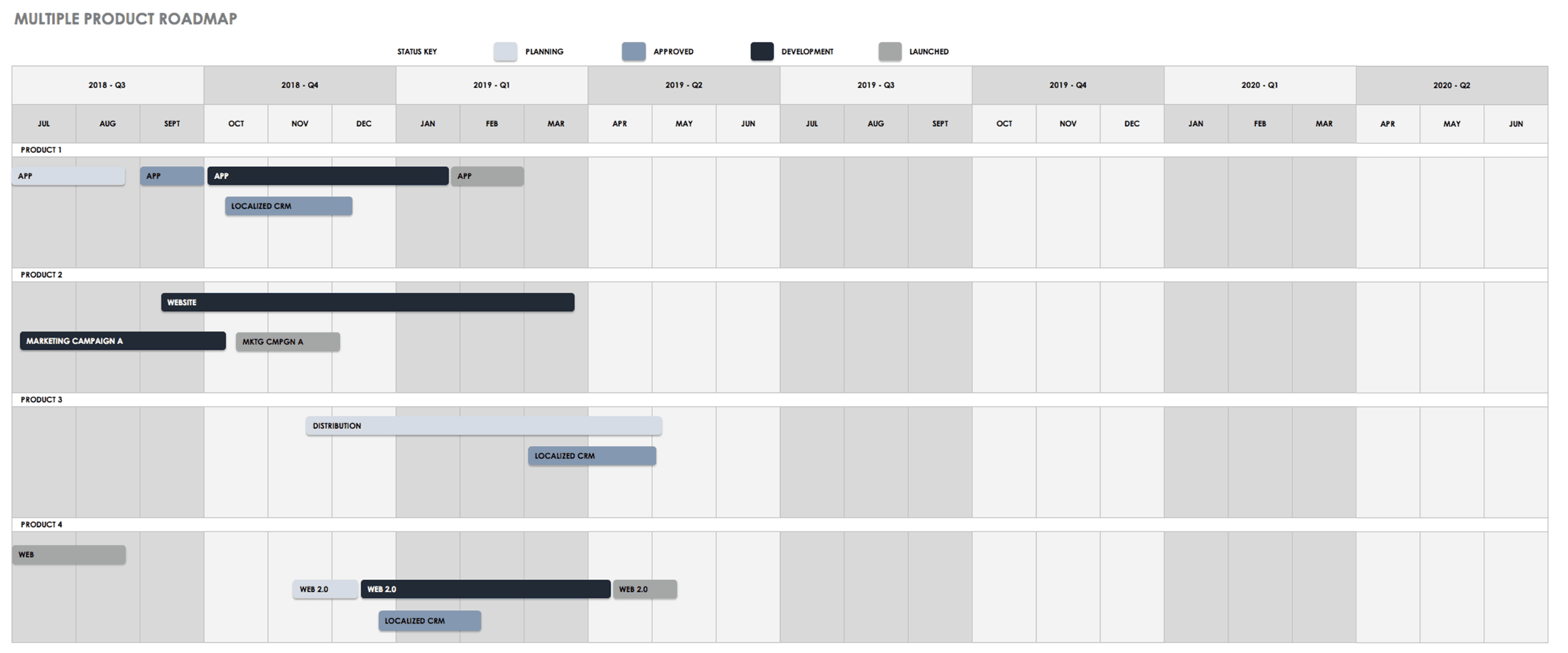
1. Download and Open the Template
Download the template by clicking on the download button. A new PowerPoint window will open with your template.
2. Adjust Date Ranges
In the template, the roadmap is broken up by months and quarters. To adjust these dates, double-click within any of the cells and type the appropriate date ranges based on the needs of your roadmap.
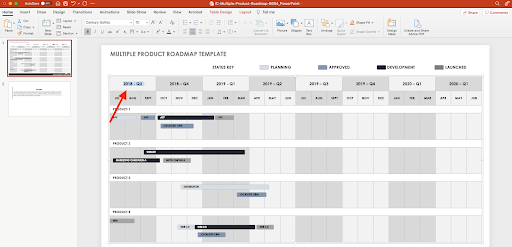
Begin each task bar at the expected start date and extend it to the expected end date.
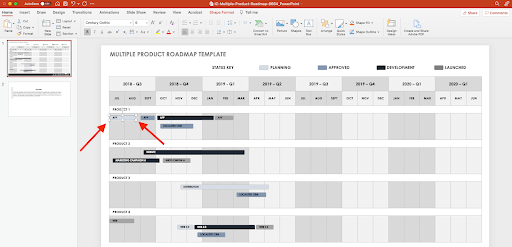
3. Add Task Bars for Each Task
Double-click on any of the task bars to rename them based on the specific tasks or activities in your roadmap.

4. Group Bars by Team or Initiative
To better organize your roadmap, group your task bars by team or initiative. These groupings are also known as swimlanes, and make it easy to understand the roadmap at a glance.
In our example template, the tasks are grouped together by different teams, like product, development, user experience, and quality assurance.
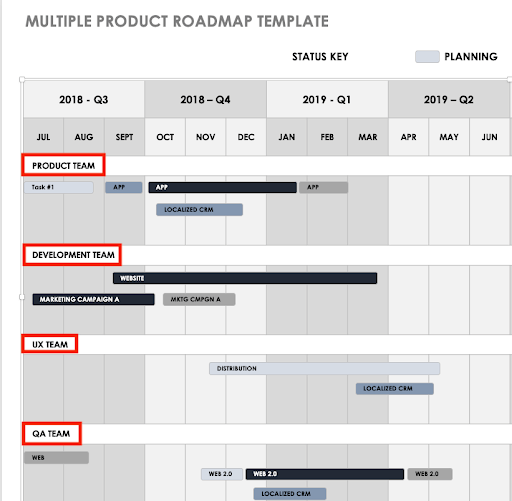
5. Stack Bars by Feature
Stack sequential tasks that are part of the same initiative in the same row so you can easily identify tasks by phase. This organization also helps signify dependencies among tasks.
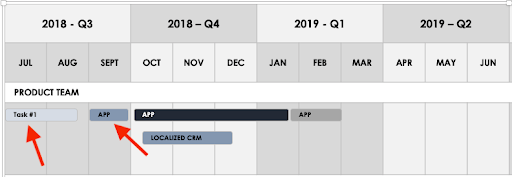
How to Create a Product Roadmap Using a Gantt Chart
If you’re more comfortable with Gantt charts and are looking to create a product roadmap using one, you can use one of our free Gantt chart templates and follow these easy steps.

1. Download and Open the Template
Download the template by clicking on the download button. A new Excel window will open with the template.
2. Add Project Phases and Tasks
In the Task Title column, add your product roadmap phases and the associated tasks. Double-click within a cell and type the phase or task name.
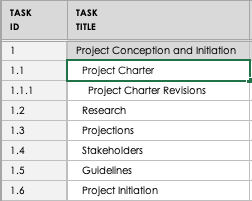
3. Add Task Owners
Once you input all your product phases and the corresponding tasks into the Gantt chart, add task owners for each so you can keep track of who is in charge of what.

4. Add Start and End Dates
Next, click within either the Start Date or End Date column and input dates for each task. The template includes a built-in formula that will automatically change the number in the Duration column based on the start and end dates you input.
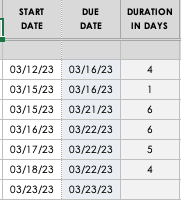
5. Add Percentage Complete
In the PCT of Task Complete column, input how far along the product phase or task is by updating the percentage. Click within the cell to adjust the percentage.

6. Fill In the Gantt Chart Cells
To represent this data in a Gantt chart, you’ll need to update the cell fill colors to correspond with the start and end dates of your tasks. Click within any of the individual cells on the Gantt portion of the template and click on the paint bucket icon in the top navigation bar. Click the color you want to fill the cell.
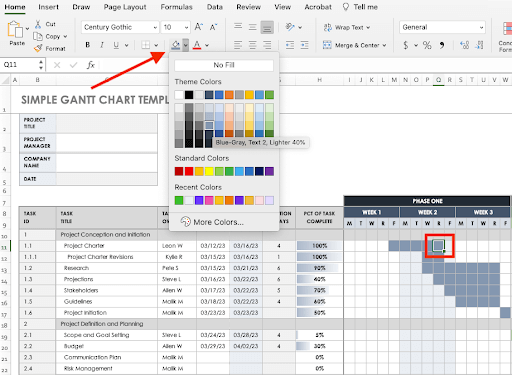
Continue to fill in the appropriate number of cells so you accurately represent your phases and the start and end dates for each associated task.
How to Create a Product Roadmap in Smartsheet
Since roadmaps are meant to be flexible and collaborative, a tool like Smartsheet, a powerful dynamic work platform, can help you create, collaborate on, change, update, and implement a product roadmap across your organization.
To create an effective product roadmap in Smartsheet, follow these simple steps.
1. Open the Template
Open the template by clicking on the download button. This action will open up Smartsheet and land you directly in the Multiple Product Roadmap template.
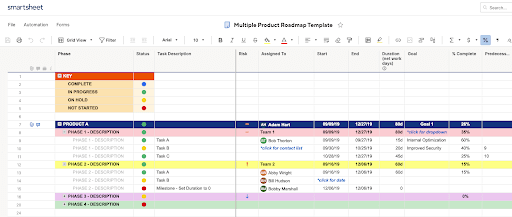
2. Input Phases
In the Phase column, add phases and subsequent tasks in hierarchical order. Double-click within any of the cells and input the name of your phases and tasks.
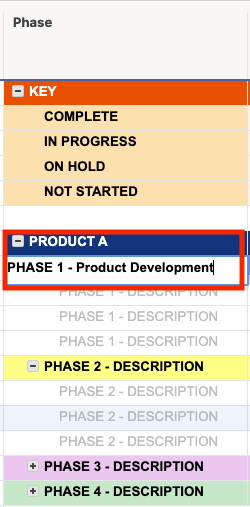
3. Update Phase Status
Once you set up the phases and tasks, you can set their status using different symbols, like the red, yellow, green, and blue balls in the example below. The colored ball gives an at-a-glance view of tasks that are in progress, complete, or at risk, so everyone can stay in the know.
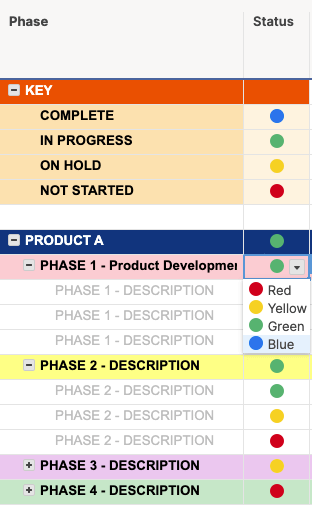
4. Add Task Descriptions
Add task descriptions within each corresponding row so stakeholders can get a better sense of what’s happening within each task and the expected outcome.
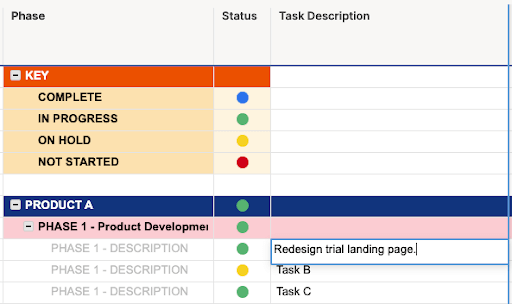
5. Identify Associated Task Risks
Assign each task a risk level. Doing so will alert you to any tasks that you need to keep a closer eye on.
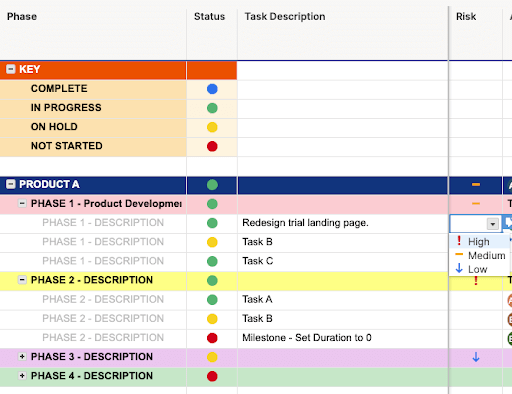
6. Assign Tasks to Team Members
Add a person responsible for each task in the Assigned To column. Doing so will keep team members accountable and will also inform stakeholders of who to approach with questions.
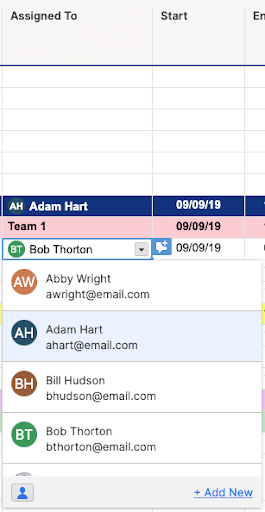
7. Add Start and Ends Dates
Adjust start and end dates for each task. As you adjust the dates, the duration (in the following column) will automatically update to display net work days.
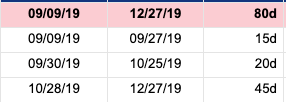
8. Update Strategic Goals
Add your organizational goals directly to the roadmap in the Goal column. This step will help you better understand which tasks are geared toward what strategic goals.
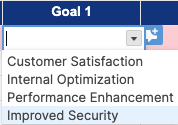
9. View Your Roadmap in Gantt View
Switch your roadmap to Gantt view to see your tasks in a sequential timeline. This view will help everyone better understand predecessor and dependent tasks, as well as the overall product progress.
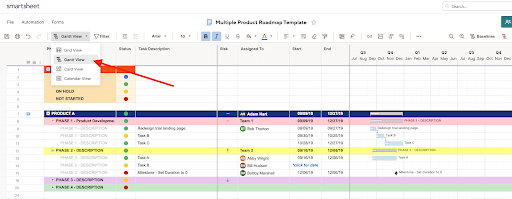
Create a Collaborative Product Roadmap with Smartsheet
Empower your people to go above and beyond with a flexible platform designed to match the needs of your team — and adapt as those needs change.
The Smartsheet platform makes it easy to plan, capture, manage, and report on work from anywhere, helping your team be more effective and get more done. Report on key metrics and get real-time visibility into work as it happens with roll-up reports, dashboards, and automated workflows built to keep your team connected and informed.
When teams have clarity into the work getting done, there’s no telling how much more they can accomplish in the same amount of time. Try Smartsheet for free, today.